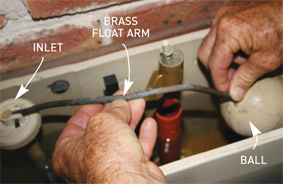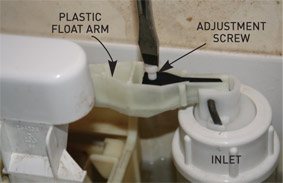
- If the water level is too high, adjust the float arm.
- Replace inlet valve washer if faulty.
- Dismantle and clean the inlet valve if clogged.
- If the float fouls on the inside of the cistern, adjust it to clear obstacles.
- If the outlet valve suction rubber at the cistern base is faulty, replace it.
- Contact a plumber for advice.
Step 1: Check for leaks
Remove the cistern lid. Check for leaks that can go unnoticed by dripping vegetable dye into the cistern – the dye appears in the bowl if there’s a leak. Locate the cause of the leak and if the float level is incorrect, follow steps 2 and 3.

Step 2: Lower the float arm
If the cistern overfills and flows continuously into the bowl, adjust the float arm down so the ball sits lower in the cistern, shutting the inlet valve off earlier. With older cisterns, the brass arm can be bent down.

Step 3: Adjust the float levels
On a new toilet with a plastic float arm, turn the adjusting screw on top of the float arm and ball, raising or lowering to the correct position for shutting off the inlet valve.
TIP: There are usually markings to indicate the correct water level.







